|
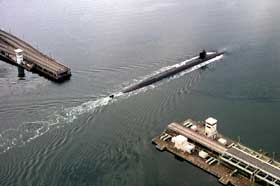 TODAY,
the strategic deterrence policy of the United States is
based on Triad, with dependence on its three elements -
intercontinental ballistic missiles (ICBM), strategic
bombers, and submarine-launched ballistic missiles (SLBM).
There have been volumes written on Triad, explaining its
merits and deficiencies, but its key attributes can be
outlined quite simply. Each of the three Triad components
contributes three quite different threats to the Soviet
Union as a result of their individual operating
environments, technical characteristics, and modes of
deployment. Because of these distinct differences, Triad
represents an enormous threat to the Soviets, one that
takes a tremendous expenditure of national resources to
counter, if indeed each component can be defended against
to a satisfactory degree. The Soviets have invested
heavily in a variety of detection and defense
technologies. TODAY,
the strategic deterrence policy of the United States is
based on Triad, with dependence on its three elements -
intercontinental ballistic missiles (ICBM), strategic
bombers, and submarine-launched ballistic missiles (SLBM).
There have been volumes written on Triad, explaining its
merits and deficiencies, but its key attributes can be
outlined quite simply. Each of the three Triad components
contributes three quite different threats to the Soviet
Union as a result of their individual operating
environments, technical characteristics, and modes of
deployment. Because of these distinct differences, Triad
represents an enormous threat to the Soviets, one that
takes a tremendous expenditure of national resources to
counter, if indeed each component can be defended against
to a satisfactory degree. The Soviets have invested
heavily in a variety of detection and defense
technologies.
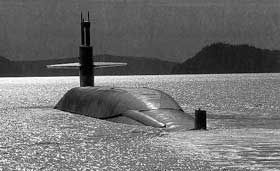 In
addition by having three elements, the United States is
hedging against a Soviet breakthrough in one defensive
technology that could degrade one of the elements. If a
breakthrough does occur, the other two elements can still
maintain a sufficient deterrence while the third one is
upgraded to overcome its shortcomings. It is extremely
unlikely that breakthroughs in defensive capabilities will
simultaneously negate two or three elements. In other
words, the United States has not placed its reliance on
one deterrence system only. In
addition by having three elements, the United States is
hedging against a Soviet breakthrough in one defensive
technology that could degrade one of the elements. If a
breakthrough does occur, the other two elements can still
maintain a sufficient deterrence while the third one is
upgraded to overcome its shortcomings. It is extremely
unlikely that breakthroughs in defensive capabilities will
simultaneously negate two or three elements. In other
words, the United States has not placed its reliance on
one deterrence system only.
By having
three independent elements, the United States has a far
greater chance to achieve and use its own technological
breakthroughs to improve its deterrence posture. We have a
threefold chance to create an improvement that will
prevent the Soviets from exploiting their strategic
systems or overcome a Soviet defensive superiority. What
is even more important is that, because Triad is an
integrated system, we can improve overall Triad deterrence
capabilities by improving the element most amenable to
upgrading at the time and the element that provides the
greatest increment of improvement for the least investment
of resources.
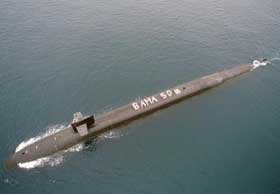 While
each Triad element has key strengths, each also has
weaknesses. However, the three elements complement one
another so that a weakness in one element is compensated
by a strong point in another. Thus when all three
elements, each with its own unique capabilities, are taken
as a whole, the sum of our deterrence posture represents
an insurmountable obstacle to an opposing strategist. Even
though he might be able to negate one or two elements, it
is the entire Triad concept that deters. It is impossible
to negate all three Triad elements simultaneously and
hence avoid a retaliatory attack. Further, it should be
noted that a single U.S. missile with its multiple
warheads which slips through Soviet defenses still may
represent an unacceptable amount of damage to the Soviets. While
each Triad element has key strengths, each also has
weaknesses. However, the three elements complement one
another so that a weakness in one element is compensated
by a strong point in another. Thus when all three
elements, each with its own unique capabilities, are taken
as a whole, the sum of our deterrence posture represents
an insurmountable obstacle to an opposing strategist. Even
though he might be able to negate one or two elements, it
is the entire Triad concept that deters. It is impossible
to negate all three Triad elements simultaneously and
hence avoid a retaliatory attack. Further, it should be
noted that a single U.S. missile with its multiple
warheads which slips through Soviet defenses still may
represent an unacceptable amount of damage to the Soviets.
Finally,
Triad gives the United States more bargaining power at the
arms limitation negotiating table: we have more options
and more items to be traded. A further confirmation of the
validity of the Triad concept is the fact that the Soviets
are adopting this three-element posture themselves.
What the
SLBM contributes to Triad
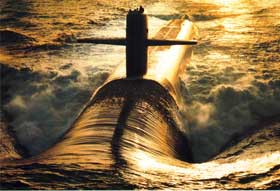 While
each Triad component has several advantages, the key
advantage of the ICBM is its quick response and accuracy
in hitting the desired target. For the strategic bomber,
it is flexibility and the ability to be recalled after
launch. The SLBM has its key advantage in its
survivability and the difficulty it presents to enemy
surveillance, detection, and defensive systems. While
each Triad component has several advantages, the key
advantage of the ICBM is its quick response and accuracy
in hitting the desired target. For the strategic bomber,
it is flexibility and the ability to be recalled after
launch. The SLBM has its key advantage in its
survivability and the difficulty it presents to enemy
surveillance, detection, and defensive systems.
The SLBM
submarine can go undetected in the vast ocean areas that
comprise a major portion of the earth's surface. A U.S.
nuclear submarine equipped with missiles that have a range
of 2500 nautical miles, like the current Polaris and
Poseidon missiles, has millions of square miles of ocean
to operate in and still be within range of targets in the
Soviet Union.1 Trident I missiles, destined for
use in the early 1980s with a full payload range of 4000
nautical miles, will have access to even four-and-a-half
times more ocean area in which to hide. The Trident II,
planned for the mid-1980s, will achieve an even greater
range and payload combination. Not only can the SLBM use
vast amounts of the earth's oceans to avoid detection, it
can stay away from port for relatively long periods of
time, thus decreasing the possibility of its being trailed
from port to its hiding place. The usual sixty-day tour on
station is not dictated by the endurance of the submarine
and its mechanical systems but is governed by the time the
crew can remain in isolation without suffering severe
decrease in efficiency and morale.
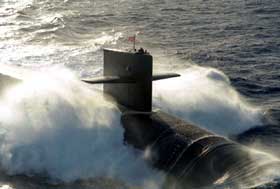 In
addition, since the SLBM submarine can be constantly
moving, the Soviets must keep real-time information on its
position. They cannot just locate it once and file the
position in the targeting computer. If they lose one
submarine, they must detect it again because of the damage
potential just one unaccounted-for submarine represents.
Although antisubmarine warfare (ASW) capabilities are
improving, there are still many countermeasures, decoys,
and quieter submarines to counter these improvements.
Thus, the SLBM's advantage from a detectability standpoint
remains secure. And because the other Triad elements are
contributing to the total deterrence picture, our
deterrence capabilities are not degraded to an
unacceptable level while these improvements are
implemented. In
addition, since the SLBM submarine can be constantly
moving, the Soviets must keep real-time information on its
position. They cannot just locate it once and file the
position in the targeting computer. If they lose one
submarine, they must detect it again because of the damage
potential just one unaccounted-for submarine represents.
Although antisubmarine warfare (ASW) capabilities are
improving, there are still many countermeasures, decoys,
and quieter submarines to counter these improvements.
Thus, the SLBM's advantage from a detectability standpoint
remains secure. And because the other Triad elements are
contributing to the total deterrence picture, our
deterrence capabilities are not degraded to an
unacceptable level while these improvements are
implemented.
In
discussing the SLBM, one would be unfair not to point out
some of its shortcomings and the environment in which it
operates. The main defense a missile-carrying submarine
has is the ability to hide: once detected and its position
known, its effectiveness is degraded until evasive action
can be taken to get lost again. Besides quieter operation
and the use of decoys to confuse the enemy's detection
systems, submarines can be made less detectable by
operating mainly in regions of the ocean where storms and
other ocean produced noise mask the submarine's own
sounds.
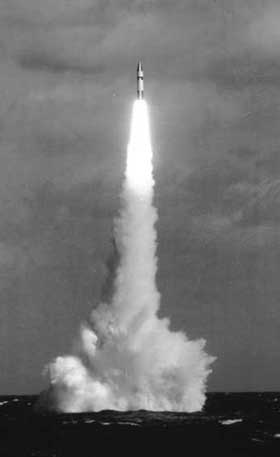 Because
the submarine is a mobile launch point, it is difficult to
know its precise location continually. Thus, since the
starting point is an important part of a ballistic
trajectory computation, the SLBM's accuracy on target is
degraded in comparison to the land-based ICBM. Inasmuch as
the SLBM carries 16 missiles-or in the case of future
Trident boats, 24 missiles--a portion of the force is
located in a single spot. A loss in capability occurs when
the submarine is in port for repairs or crew change as
well as when it is knocked out by enemy action. However,
the SLBMs can be launched from port and still reach their
targets. Also, in times of tension, more boats would be on
alert. Because
the submarine is a mobile launch point, it is difficult to
know its precise location continually. Thus, since the
starting point is an important part of a ballistic
trajectory computation, the SLBM's accuracy on target is
degraded in comparison to the land-based ICBM. Inasmuch as
the SLBM carries 16 missiles-or in the case of future
Trident boats, 24 missiles--a portion of the force is
located in a single spot. A loss in capability occurs when
the submarine is in port for repairs or crew change as
well as when it is knocked out by enemy action. However,
the SLBMs can be launched from port and still reach their
targets. Also, in times of tension, more boats would be on
alert.
Communications
and command and control present some difficulties for the
submarine force although not insurmountable.
Very-low-frequency radio signals can penetrate a short
distance into the water, so the National Command
Authorities can be in communication with the submarines
without their needing to surface and expose themselves.
Fortunately,
weak points in the SLBM are compensated for by the other
elements of Triad, and the SLBM is allowed to contribute
its unique capabilities in the area of survivability and
undetectability. The less accurate SLBM is still
sufficiently accurate for "soft" targets such as
industrial complexes and strategic bomber bases. The ICBM
and bomber-based delivery systems, with their
yield/accuracy combination, can be targeted against the
"hardened" targets such as ballistic missile
sites, hardened command centers, hardened industrial
targets, etc., where essentially a direct hit is mandatory
to achieve destruction.
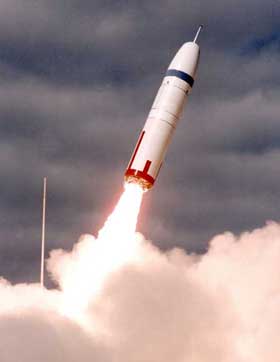 Under
normal world conditions, the usual number of
missile-carrying submarines in port and going to and from
station can be tolerated since essentially the entire ICBM
force is continually on alert. Both the ICBM and the SLBM
suffer from the inability to be recalled once launched. At
times, the world situation may dictate that the United
States merely indicate a show of force or national resolve
rather than actually launching an attack. The strategic
bomber offers this recall capability as well as several
other unique features to Triad. Under
normal world conditions, the usual number of
missile-carrying submarines in port and going to and from
station can be tolerated since essentially the entire ICBM
force is continually on alert. Both the ICBM and the SLBM
suffer from the inability to be recalled once launched. At
times, the world situation may dictate that the United
States merely indicate a show of force or national resolve
rather than actually launching an attack. The strategic
bomber offers this recall capability as well as several
other unique features to Triad.
There is a
point of controversy between the advocates of sea- and
land-based ballistic missiles. Some proponents of the SLBM
state that placing our deterrence force at sea decreases
the chance that our country and especially its urban areas
would be destroyed in a nuclear holocaust. If only our
SLBMs were attacked, it would churn up the oceans a bit
and we might lose some submarines and their crews, but our
cities could go undamaged. But this is only part of the
story. By having a single system to counter, the enemy has
a much simpler targeting problem, just as if we used
bombers or ICBMs alone. Additionally, the enemy might feel
that we would not launch an attack if our submarines
started to be destroyed. The United States would probably
think twice before launching the remaining SLBM force
against enemy cities, and because of the relative accuracy
(or inaccuracy) of the SLBMs, they can be used effectively
only against population and industrial centers. Such an
attack would risk a retaliatory response against our
cities, an unacceptable result. Thus, the U.S. could be
subjected to nuclear blackmail and required to submit to
enemy demands. As a result, the entire concept of
deterrence would be undermined. It is only because of our
maintenance of three viable elements of Triad that the
enemy would hesitate to launch any type of attack.
Consequently, we must retain a creditable deterrence
posture.
History
of Submarine Launched Ballistic Missiles
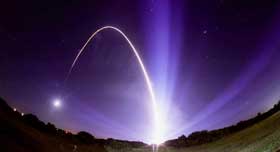 The
United States has had an operational SLBM force since
November 1960, when the first Polaris-carrying submarine,
the U.S.S. George Washington, put out to sea on
patrol This was five years after the first U.S. nuclear
submarine, the Nautilus, was launched. This
five-year period was needed to develop a solid propellant
missile system to launch an SLBM from a submerged
submarine. The first successful underwater launch of a
Polaris missile occurred in July 1960, again from the Washington.
A total of five submarines were fitted with the 1200
nautical-mile-range A-1 Polaris missiles. The
United States has had an operational SLBM force since
November 1960, when the first Polaris-carrying submarine,
the U.S.S. George Washington, put out to sea on
patrol This was five years after the first U.S. nuclear
submarine, the Nautilus, was launched. This
five-year period was needed to develop a solid propellant
missile system to launch an SLBM from a submerged
submarine. The first successful underwater launch of a
Polaris missile occurred in July 1960, again from the Washington.
A total of five submarines were fitted with the 1200
nautical-mile-range A-1 Polaris missiles.
To improve
the capability of the Fleet Ballistic Missile (FBM) force,
the 1500 nautical-mile-range A-2 Polaris was developed.
The A-2 was first launched from the U.S.S. Ethan Allen
off the Florida coast in October 1961. Eight nuclear
submarines were equipped with the A-2 missile.
The next
generation Polaris missile was the A-3, with a 2500
nautical mile range. Even though this Polaris fit in the
same launch tubes as its predecessors, it was an 85
percent new missile. 2 Besides an increase in
range, each missile now carried three warheads; however,
they were not independently targeted but were designed to
hit a target in a prearranged pattern. The first A-3 was
launched from the U.S.S. Andrew Jackson in October
1963. A month later, President Kennedy watched the
launching of another A-3 at Cape Canaveral. The A-3 became
operational with the deployment of the U.S.S. Daniel
Webster in September 1964. A total of 33 boats were
equipped with the A-3, including the original five A-1
carrying boats which were refitted with the A-3. The A-3
equipped boats represented a significant increase in
deterrence capability, for with a 2500 nautical mile range
this missile can reach any target on land. 3 By
1967, the U.S. had 41 Polaris submarines carrying either
A-2 or A-3 missiles on patrol.
The next
SLBM was so different from the Polaris that it was given a
new name, Poseidon C-3. While the Poseidon was based on
Polaris technology and still fits the same tubes, it was a
larger, heavier missile. The most important difference was
Poseidon's multiple independently targetable reentry
vehicles (MIRVs). The first launching of a Poseidon from a
submarine occurred in August 1970 from the tubes of the
U.S.S. James Madison. The first C-3s became
operational with the deployment of the U.S.S. Madison
in March 1971.
Currently,
the FBM force consists of Polaris A-3 and Poseidon C-3
missiles. Ten submarines are carrying the A-3, while the
remaining 31 have been fitted with the C-3. The earlier
A-1 and A-2 versions of the Polaris have been retired.
Systems
Submarines.
There are three classes of Fleet Ballistic Missile
submarines in operation. The early five boats of the
George Washington class with their 382-foot lengths and
6700-ton displacements carry the A-3 Polaris now. The
boats of the 410-foot, 7900-ton Ethan Allen class also
launch the A-3. The Poseidon-carrying boats consist of 31
Lafayette-class submarines with their 425-foot lengths and
8250-ton displacements. The submarines are powered by
steam turbines that get their energy from water-cooled
nuclear reactors. With an atmospheric control system of
immense capacity, the submarine does not even have to
raise a snorkel to obtain air. If it were not for the
needs and endurance of the human crew, these submarines
could stay on station almost indefinitely. Each submarine
carries a crew of 12 to 14 officers and about 130 enlisted
personnel, and each has two crews, a Gold and a Blue one.
While one crew is on patrol, the other is in port
training, orienting new crew members, taking leave, and in
general getting ready for the next cruise. Normally, the
submarines are on station for sixty-day periods.
The Polaris
and Poseidon missiles are launched from the submarine's 16
tubes while the craft is submerged and out of sight. The
missile is ejected from the tube either by compressed air
or by a gas and steam generator system. Once the missile
reaches the water's surface, the first stage of the
missile is ignited and sent on its way. There is access to
each of the 16 independently controlled launch tubes even
during patrol at sea for performing inspection and
maintenance of the missiles.
Missiles.
The Polaris's two stages are filled with solid
propellants. The first stage of the A-2 version of Polaris
used a steel case, while its second stage and both stages
of the A-3 have glass-fibre cases. Incidentally, the
Polaris was the first large solid-rocket motor to have a
glass-fibre case. The A-3 is 32 feet long, an inch longer
than the A-2, both missiles having a 54-inch diameter. The
A-2 and A-3 have total weights of 30,000 and 35,000
pounds, respectively.
The
Poseidon is also a two-stage missile with its solid
propellants carried in glass-fibre cases. The Poseidon has
a substantially larger payload capacity, achieved mainly
by its larger size which allows it to carry as many as 14
MIRVed warheads. It is 34 feet long, has a 74-inch
diameter, and weighs 65,000 pounds.
The Polaris
and Poseidon missiles have inertial guidance systems for
directing the missile on a ballistic trajectory after
launch from the submarine tubes. The system compensates
for winds and other flight effects, keeps the missile in a
stable flight attitude, and triggers the separation of the
reentry vehicle (RV) from the missile to allow the RVs to
continue on their ballistic trajectories to their targets.
In order for the SLBMs to reach their targets accurately,
very precise targeting information must be fed into the
missile guidance memories prior to launch. Since the
trajectories change as the submarine moves around,
trajectory input data must be constantly updated. This is
the function of the Polaris/Poseidon's fire control
system. This system consists of a high-capacity digital
computer that takes data such as the submarine's location,
the local vertical direction, true north, and the target
location and updates trajectories for each of the 16
missiles every few seconds. This system can prepare
missiles for launch at a rate of one about every minute. 4
Support
facilities. There
is more to the FBM fleet than just the submarines and
missiles. First, there is the worldwide communications
newtwork that ensures positive control over the launching
of the missiles to assure that they can be launched if
necessary at the command of the President. Land-based,
airborne, and satellite transmitters all playa part in
this network. By use of very low-frequency radio
transmitters, positive control can be maintained with the
always submerged submarines without revealing their
locations.
Then there
is the fleet of support vessels, including several
submarine tenders for maintaining and resupplying the
submarines while at sea and transports for carrying
missiles. A converted cargo ship, the U.S.S. Compass
Island is used to verify the accuracy of the
navigation systems of the submarines which pinpoint their
location at all times. A specially configured Operational
Test Instrumentation Ship, the U.S.N.S. Range Sentinel,
is used for flight safety and to gather telemetry data
during operational test flights of the missiles.
Finally,
there are the land-based support facilities. Several
shipyards on both the East and West Coasts not only built
and initially fitted-out the boats but they also
overhauled and refitted the new types of missiles and
modernized the submarines themselves. To train the crewmen
to meet the highly technical and demanding jobs aboard an
SLBM submarine, the Navy has several specialized schools
that teach everything from basic digital computer theory
to nuclear power-plant operation. There are initial
training schools that convert basic recruits to missilemen
as well as advanced and refresher courses in every aspect
of FBM duty. Since the FBM fleet uses both the Atlantic
and Pacific oceans, operational support facilities are
located on both coasts. Missile assembly facilities at
Charleston, South Carolina, and Bangor, Washington, can
assemble missiles from completed subsystems and sections
supplied by contractors, check them out, store them, and
finally load them aboard submarines, their tenders, or
resupply transports. Naval shipyards at Charleston and at
Bremerton, Washington, are equipped to perform maintenance
and check-out of the submarines themselves. Finally, there
are extensive facilities and test ranges used in
developing and testing the entire SLBM system. The chief
testing site is at the Air Force Eastern Test Range at
Patrick Air Force Base, Florida. Here are the launching
pads and blockhouses in addition to all sorts of missile
assembly, check-out, instrumentation, supply, and
administration buildings needed for development launches
of new missiles. Additional testing is done at such
locations as the Pacific Missile Range off the coast of
California and at the Navy's China Lake facility in the
heart of the California desert.
Trident
I and II
The Navy
currently has new missiles and submarines under
development. They are the Trident I and II missiles, which
use advances in technology to achieve greater range and
accuracy. * There are also the new, larger Trident
submarines, which will carry more missiles, use new
technology to be quieter and faster, and employ advances
in command and control techniques. They will be replacing
the older of the Polaris/Poseidon boats, which will be
reaching their projected twenty-year service lives by the
early 1980s. By 1987, all the current 41 FBM submarines
will be more than twenty years old.
*TRIDENT
Test Successful. Navy's new TRIDENT ballistic missile
was successfully test-fired in late April from a pad at
Cape Canaveral, Fla., with all three stages working.
This was the fourth test and some 20 to 25 more pad
launches are scheduled before submarine launches are to
be tested sometime in the summer of 1979. Commanders
Digest/May 12, 1977, p. 4.
The Trident
I missile is designed to fit the same missile tubes as the
Poseidon but achieve almost twice its range. Ten of the
Poseidon boats will be fitted with these new missiles. In
order to get more than 4000 nautical miles range out of
the 74-inch diameter by 34-foot package, the Navy has done
many things. First, a third stage has been added. Second,
more energetic and denser propellants are packed into all
stages to provide more efficient use of the propellant
load.
Finally,
many of the missile components have been made lighter so
that weight saving can be applied to increasing range.
More compact and lighter microelectronic circuits have
been used in the design. Graphite epoxy materials have
been substituted for aluminum, giving the same strength
for half the weight in many of the missiles's load
carrying structures. The nose of the Trident, which is
subjected to searing temperatures while flying through the
atmosphere, has a unique design. First, the nose is made
of Sitka spruce wood. This material can sustain the heat
load, is a good insulator, and is able to handle the loads
during hoisting and loading aboard the submarine. Buried
in the nosecap is an aerospike device that pops out during
flight. At supersonic speeds, a shock wave is formed on
this spike and drastically reduces the drag on the blunt,
ogive-shaped nose of the missile. The postboost control
system that drives the missile payload to the right
location so that the warheads can reach the proper target
is designed to operate at higher temperatures, thus
reducing the weight for its thermal protection equipment.
In all, these nonpropulsion items contribute hundreds of
nautical miles of increased range.5
The first
Poseidon submarine will be refitted with the Trident I
missile in fiscal year 1979, and a total of ten submarines
will be refitted through FY 1982. Although a goal of the
Trident design was to retain as much commonality with the
Poseidon missile as possible, the Trident will use about
30,000 individual pieces of equipment different from those
in the Poseidon. 6
A second
generation Trident missile is also being planned for the
1980s. This is the larger Trident II missile which will
capitalize on Trident I technology. In addition to the new
missile, new submarines are also being built. These are
the larger Trident boats with their 24 missile tubes.
These boats will be made quieter and faster by using
improved nuclear power plants. For example, for quieter
operation, the submarine will use quieter air reducers and
will be equipped with advanced sound isolation. These new
boats will be fitted initially with Trident I missiles;
however, by the mid-1980s they will be operational with
Trident IIs aboard. The Trident submarines will be
considerably larger than the Poseidon boats, 560 feet long
versus 425 feet. This additional size will not only
accommodate eight additional missiles but will allow more
room for the crew, which will be essentially the same size
as the current crews.
The
increased range of the Trident system will provide for
more than just a larger portion of the ocean in which to
hide. The increased range allows basing to be entirely
within the continental United States, thus eliminating
costly and sometimes politically unstable overseas bases.
The Trident-carrying boats can be on station virtually as
soon as they leave port. This means more time on station
during each patrol. So in reality there will be more
missiles ready for launch at any one time.
For the
Trident system, the Navy plans to have ship refit, missile
support, base support, and crew training located entirely
within the United States. This means reduced personnel
costs and greater stability for the crews and their
families, When not at sea, the men will perform all the
shore preparations and training at home, greatly reducing
travel costs and hopefully increasing the retention rates
highly skilled but volunteer crewmen. Although Polaris
submarines have operated in the Pacific since 1964, basing
of the Trident system in the Pacific will, in conjunction
the Atlantic-based Poseidon force, confront the Soviets
with an extensive two-ocean threat. This threat will be
expensive to counter and probably could not be very
effectively countered without bases near the coastline of
the United States. 7
THE CONCEPT
of Triad was perhaps best summarized by Secretary of
Defense Donald H. Rumsfeld during Hearings before the
House Armed Services Committee in support of the fiscal
year 1976 military budget.
U.S.
strategic nuclear deterrence continues to be based on a
Triad of strategic forces, These forces are designed to
ride out a surprise attack and retaliate in a controlled
second-strike at Presidential direction. A combination
of ballistic missiles-land- and sea-based-and heavy
bombers is necessary to diversify the strategic forces
sufficiently, so that neither system failures nor enemy
ingenuity could prevent retaliation. Responsive command
and control of these forces is essential to deal with
the possibility of less than all-out attacks and to
terminate a nuclear exchange at the earliest moment
possible if, despite best efforts, deterrence should
fail. 8
The United
States SLBM fleet has contributed its unique capabilities
of survivability and deception to Triad for over a decade.
Polaris and Poseidon have served well and will continue to
do so for some time into the future. However, this
capability will be augmented by an even more capable
system, the Trident missile and submarine,
United
States Military Academy
Notes
1. Herbert
Scoville, Jr., "Missile Submarines and National
Security," Scientific American, June 1972, p.
18.
2.
"Polaris and Poseidon-FBM Facts," Strategic
Systems Project Office, Navy Department, 1973, p. 7.
3. Ibid.
4. Ibid.,
p. 13.
5. Clarence
A. Robinson, Jr., "New Propellant Evaluated for the
Trident Second Stage," Aviation Week & Space
Technology, 13 October 1975, p. 15.
6.
"Trident Subsystem Tests in Final Phase," Aviation
Week & Space Technology, November 3, 1975;, p. 38.
7. Tom
Nugent, "The Trident Story," All Hands,
February 1975, p. 6.
8.
Statement by the Honorable Donald H. Rumsfeld, Secretary
of Defense, Hearings on Military Posture before the House
of Representatives' Armed Services Committee, 94th
Congress, 27 January to 11 February 1976 (U.S. Government
Printing Office: House Armed Services Committee, 94-13).
The
illustrations for this article are official United States
Navy photographs.
Contributor
Lieutenant
Colonel William D. Siuru, Jr., (Ph.D., Arizona State
University) is an Instructor and Course Director in the
Department of Engineering, United States Military Academy.
He has spent his entire military career in the research
and development field, with assignments at the Air Force
Rocket Propulsion Laboratory, the Space and Missile
Systems Organization, and at Wright-Patterson AFB. Colonel
Siuru is the author of many articles and books on
technical subjects, including previous articles in Air
University Review.
Disclaimer The conclusions and
opinions expressed in this document are those of the
author cultivated in the freedom of expression, academic
environment of Air University. They do not reflect the
official position of the U.S. Government, Department of
Defense, the United States Air Force or the Air
University.
|